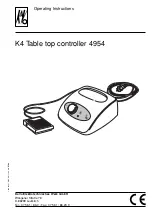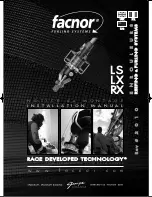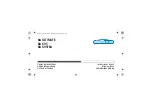
2
ARBEITSHALTUNG DER PIPETTE
(Fig. 2)
Der anwenderfreundlichen Form der Calibra
®
Pipette
wurde besondere Aufmerksamkeit geschenkt. Man ar
-
beitet entspannt mit der Fingerstütze auf dem dritten
Glied des Zeigefingers, den Abwurfknopf gegen sich
gerichtet.
SPITZEN UND FILTER
Die Qualitips
®
Pipetten Spitzen mit oder ohne Filter er
-
geben für jede Anwendung die bestmögliche Kombina
-
tion von Pipette und Spitze. Siehe Bestellinformationen
Seite 4. Detailliertes Blatt auf Anfrage.
Die Reproduzierbarkeit verbessert sich, wenn jede Spit
-
ze vor Gebrauch mit dem Pipettiergut einmal durchge
-
spült wird (Auffüllen – Entleeren – Ausblasen).
Standardspitzen sind bei 121
o
C autoklavierbar. Filter
-
spitzen werden autoklavierbar oder steril geliefert.
ABDICHTUNG
Damit die Pipette optimal funktioniert, muss der Luft-
polster der Pipette dicht abgeschlossen sein. Undich-
tigkeit lässt sich durch ein leichtes Rinnen der
Flüssigkeit an der Spitze feststellen.
Folgende Stellen können undicht sein:
1. Verbindung zwischen Spitze und Konus
2. O-Ring welcher den Kolben abdichtet
3. Beschädigter Konus
Um einem eventuellen Flüssigkeitsverlust abzuhelfen,
ist zuerst die Spitze auszuwechseln. Bleibt das Problem
bestehen, muss der O-Ring ersetzt werden. Die Abnut-
zung des O-Rings ist normalerweise gering, jedoch
manchmal höher bei zahlreichem Autoklavieren. Dem
-
nach wird eine häufigere Kontrolle der Dichtung ver
-
langt. Ein beschädigter Konus sollte ausgewechselt
werden.
HOLDING MICROPIPETTE
(Fig. 2)
The ergonomic shape of the Calibra
®
greatly reduces
operator fatigue. Place fingerrest on the phalanx of
forefinger with ejector knob turned towards yourself.
Ease of access of both push button and ejector knob al-
lows natural and comfortable thumb movement.
TIPS AND FILTERS
Disposable Qualitips
®
pipette tips with or without filter
were carefully designed to provide the best pipette and
tip combination for all types of applications. See p. 4 for
ordering information. Detailed flyer on request.
Rinsing every new tip once with the pipetting solution
(fill – empty – expulse) will improve precision.
Regular tips are autoclavable at 121
o
C. Filter tips are ei
-
ther autoclavable or supplied in a sterile version.
TIGHTNESS
To work correctly, the air chamber of the pipette has to
be tight. Leaks can be detected by observing the tip: a
droplet falling from the extremity signals a leak in the
system.
Following spots have to be watched for leakage:
1. Matching of the tip on nozzle
2. O-ring providing tightness to the plunger
3. Damaged nozzle
Leakage will usually be eliminated by changing the tip.
If the problem remains, change the O-ring. The wear of
the O-ring is very slow under normal use, somewhat
faster under frequent autoclaving. Sterilization there
-
fore requires higher frequency tightness control. A
damaged nozzle should be changed.
PIPETTING OPERATION
(Fig. 3)
Forward pipetting mode:
Phase 1
Depress plunger button to the intermediate
stop ending calibrated stroke before im-
mersing tip into appropriate reagent con-
tainer.
Phase 2
Immerse tip vertically 2-3 mm into liquid and
smoothly release plunger button. Withdraw
tip from liquid vertically after 2-3 seconds.
Phase 3
Place tip against wall of receiving vessel,
depress plunger button to first stop and let
liquid out. Depress button to second stop:
the excess air volume produced by depress
-
ing the plunger beyond the calibrated stroke
blows out possible fluid particles which may
cling to the tip.
Tip
Eject used tip by pressing ejector (E)
ejection
as shown in Fig. 3. Change tip per recom
-
mendations in previous section.
Reverse pipetting mode also possible with the
Calibra
®
pipettes.
PIPETTIERVORGANG
(Fig. 3)
Normal Pipettiervorgang:
Phase 1
Bevor die Spitze zum Ansaugen in die Flüs
-
sigkeit eingetaucht wird, Betätigungsknopf
bis zum ersten Anschlag (Ende des kalibrier
-
ten Arbeitshubes) drücken.
Phase 2
Spitze vertikal ca. 2-3 mm tief eintauchen
und Knopf langsam freilassen. Zwei bis drei
Sek. warten, dann Mikropipette
herausnehmen.
Phase 3
Spitze an der Wand des zweiten Behälters
plazieren und Betätigungsknopf langsam bis
zum ersten Anschlag drücken. Die Flüssig
-
keit wird ausgestossen. Danach Betätigungs
-
knopf bis zum zweiten Anschlag
durchdrücken. Die durch den Überhub beför-
derte Luftmenge bläst nun die letzten Rück
-
stände aus der Spitze.
Spitzen-
Abwerfen der gebrauchten Spitze
abwurf
erfolgt durch Betätigen des Abwurfknopfes
(E) gemäss Fig. 3. Neue Spitze aufsetzen.
Die Benutzung der Calibra
®
Pipette ist auch mit Revers-
pipettier-Vorgang möglich.
PRISE EN MAIN DE LA PIPETTE
(Fig. 2)
La forme ergonomique de la Calibra
®
permet un travail
de longue durée sans fatigue. Placer le bouton éjecteur
face à l’utilisateur, puis poser l’appuie-doigt sur la
phalange de l’index. Actionner les boutons par simple
pression du pouce.
EMBOUTS ET FILTRES
Afin d’exploiter au maximum les possibilités de l’ins
-
trument, les embouts Qualitips
®
avec ou sans filtre ont
été définis avec le plus grand soin et permettent de
choisir la combinaison pipette/embout optimale pour
chaque application. Voir p. 4 pour commande. Feuillet
détaillé sur demande.
On améliore la reproductibilité en rinçant une fois cha-
que nouvel embout avec le liquide à doser (remplir – vi-
der – expulser).
Les embouts standards peuvent être stérilisés à 121
o
C.
Les embouts à filtre sont autoclavables ou disponibles
en version stérile.
ÉTANCHÉITÉ
Pour que la pipette fonctionne bien, la chambre conte
-
nant le coussin d’air doit être étanche. Un défaut
d’étanchéité se manifeste par la formation d’une gout
-
telette qui tombe de l’extrémité de l’embout.
Les points à surveiller sont:
1. Jonction cône porte-embout et embout
2. O-ring assurant l’étanchéité du piston
3. Cône porte-embout abîmé
Pour remédier à une éventuelle fuite, on changera
d’embout. Si le problème persiste, changer le O-ring.
L’usure du O-ring est habituellement très faible. La
déformation peut être plus importante lors de stérili-
sations répétées. C’est pourquoi l’autoclavage s’ac
-
compagne d’un contrôle plus fréquent de l’étanchéi
-
té. Si le cône porte-embouts est endommagé, il faut
remplacer la pièce.
OPÉRATION DE PIPETTAGE
(Fig. 3)
Pipettage en mode direct:
Phase 1
Enfoncer le bouton-poussoir jusqu’à la
première butée (course étalonnée) avant de
plonger l’embout dans le liquide à prélever.
Phase 2
Immerger l’embout verticalement de 2-3 mm
dans le liquide et relâcher doucement le bou-
ton. Attendre 2 à 3 sec. puis retirer la pipette
verticalement.
Phase 3
Placer l’embout contre la paroi du second
récipient et enfoncer le bouton-poussoir
jusqu’à la première butée. Laisser s’écouler
le liquide puis enfoncer complètement le
bouton: l’excédent d’air ainsi expulsé
(surcourse) permet de chasser tout résidu de
liquide se trouvant encore dans l’embout.
Ejecter
Ejecter l’embout usagé en pressant
l’embout
le bouton éjecteur (E) selon Fig. 3. Changer
d’embout selon les recommandations des
paragraphes précédents.
La pipette Calibra
®
est aussi utilisable en mode de
pipettage inverse.






















